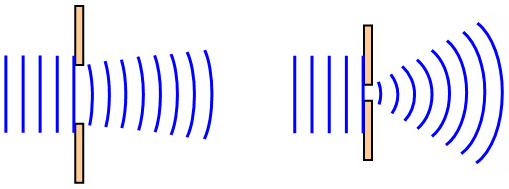

von Laue used as a diffraction grating for studying X-ray diffraction a crystal in which the atoms (ions) were arranged in regular order.ĭiffraction has played a major role in the study of the nature of microparticles. For instance, insofar as X rays have a wavelength ranging from hundreds of angstroms to 0.00001 angstrom, it is impossible to manufacture a diffraction grating with such a distance between the slits, and therefore the German physicist M. This same factor leads to many technical difficulties in studying the wave properties of other objects. Therefore, the diffraction of sound, seismic, and radio waves for which this condition is almost always satisfied (X extends from approximately a meter to a kilometer) can be easily observed, while it is much more difficult to observe the diffraction of light (λ ~ 400-750 nanometers) without special devices. Diffraction is observed most distinctly in those cases when the size of the obstacles being rounded is commensurate with the wavelength. When the number of equally spaced slits (the diffraction grating) is large, sharply separated directions of mutual wave amplification result.ĭiffraction depends significantly on the ratio between the wavelength λ and the size of the object that causes diffraction.

As the number of slits increases, the maxima become narrower. If the screen has two small apertures or slits, the diffracting waves are superimposed on one another and, as a result of wave interference, produce a spatially alternating distribution of the amplitude maxima and minima of the resultant wave with smooth transitions from one to the other. Therefore, by placing a screen with a small aperture (having a diameter on the order of the wavelength) in the path of the waves, we will obtain in the aperture of the screen a source of secondary waves from which a spherical wave is propagated, also entering the region of the geometric shadow. According to this principle, in considering the propagation of a wave, every point of the medium that this wave has traversed may be considered a source of secondary waves. Diffraction can be explained in the first approximation by using the Huygens-Fresnel principle. The reception of radio signals in the long-wave and medium-wave bands far beyond the limits of direct visibility of the radiating antenna is due to the diffraction of radio waves around the surface of the earth.ĭiffraction is a characteristic feature of the propagation of waves regardless of their nature. The possibility of hearing the voice of a person around the corner of a house is due to the diffraction of sound waves. Because of diffraction, waves bend around obstacles, penetrating into the region of the geometric shadow. Results are widely applicable in, for example, machine design and structures analysis, composite materials, analysis of flaws in materials, and earthquake resistance.Phenomena observed when waves pass by the edge of an obstacle and which are associated with a deviation of the waves from rectilinear propagation upon interaction with the obstacle. A decade later, there were many this volume summarizes an extensive literature. When Rand began studying survivability of hardened military systems in 1960, there were few solutions and few numerical results for dynamic stress concentration factors. Ironically, the elastic solid theory used was originally developed to explain the diffraction of light - and was abandoned after the electromagnetic wave and quantum theories of light appeared. The report shows clearly that the scattering of elastic (stress) waves is no different from the scattering of sound or electromagnetic waves, and much of the analysis is based on wave propagation methods. A systematic presentation of methods for analyzing both steady and transient stress loadings on diverse objects under various circumstances, and specific numerical findings for dynamic stress concentrations on objects of different shapes.


 0 kommentar(er)
0 kommentar(er)
